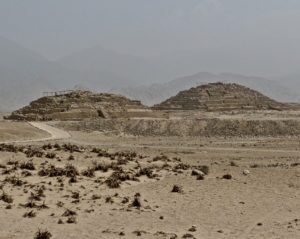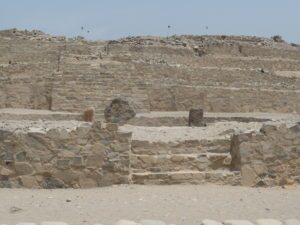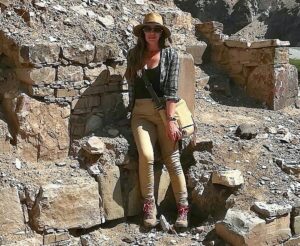 A view of the great pyramids at Caral. Dr. Kimberly Munro
A view of the great pyramids at Caral. Dr. Kimberly Munro The great Step Pyramid of Djoser in Egypt is popularly touted as the first and oldest ancient monumental pyramid ever built.
But think again.
Even before the ancients raised their massive stones in place in Egypt, more than 7700 miles to the southwest, on another continent, ancient people were constructing massive monumental structures, including pyramidal edifices in what is today known as Peru. At sites like Caral, Bandurria, Aspero, Huaricanga, and Sechin Bajo, all located within the north/central coastal region of Peru, massive construction requiring organized, community effort was underway as early as 3500/36000 BCE. That’s nearly 1,000 years before the Djoser pyramid and about 500 years before the Sialk zigurrat, the oldest Mesopotamian zigurrat, located in present-day Iran.
Dr. Kimberly Munro, an Andean archaeologist, has been exploring and investigating ancient sites in Peru for over a decade. She is the director of the Cosma Archaeological Project, a long-term research project involving excavation and survey in the Andean central highlands. “For the Andean region specifically, the origins of state development has long been debated,” writes Munro in an article recently published in Popular Archaeology. “The Andes is a peculiar case study, given that unlike the other 5 “cradles of civilization” located throughout the rest of the Prehistoric world, Andean state development did not rely entirely on an agricultural revolution. Large scale public monuments are found along the coast by at least 3700 BCE, and many early centers, especially in the highlands, predate intensive agriculture.”
_______________________________

Detail view of one of the pyramids of Caral, which dates back to 2800 BCE. Kimberly Munro
_______________________________
Notwithstanding these early site discoveries, she maintains, there is room to question the suggestion by many archaeologists that this early development arose first in the coastal and lower river valley regions. There may be reason to seriously consider looking eastward toward the highlands, as well, to sites like Kotosh, near the town of Huánuco in the central highlands. She also points, for example, to a site known as La Galgada, located on the Tablachaca branch of the upper Santa River Valley at 1,100 masl (meters above sea level) in Peru’s Department of Ancash region. La Galgada features massive dual mounds, temples, and a sunken circular plaza. “Dates for La Galgada range from 3000 to 1700 BCE,” she wrote to Popular Archaeology. “However, the base of the mound and presumably earliest constructions were never reached, indicating there may be earlier structures deep within the complex.”
 Munro relates what is known to date about these ancient Peruvian cities in a major feature premium article now published at Popular Archaeology. She also plans to lead groups of interested participants on special tours/treks of these ancient sites, and many more, in the future. Anyone interested in participating in this activity may send an email expressing interest to populararchaeology@gmail.com. As these activities are developed, interested potential participants will be informed of the details and provided the opportunity to register with the group. Readers can also follow Dr. Munro’s archaeology updates on Instagram: @the.field.professor. Pictured here, Dr. Munro is on location at La Galgada.
Munro relates what is known to date about these ancient Peruvian cities in a major feature premium article now published at Popular Archaeology. She also plans to lead groups of interested participants on special tours/treks of these ancient sites, and many more, in the future. Anyone interested in participating in this activity may send an email expressing interest to populararchaeology@gmail.com. As these activities are developed, interested potential participants will be informed of the details and provided the opportunity to register with the group. Readers can also follow Dr. Munro’s archaeology updates on Instagram: @the.field.professor. Pictured here, Dr. Munro is on location at La Galgada.
Cover Image, Top Left: View of the pyramids of Caral. Kimberly Munro
_____________________________
Advertisement




